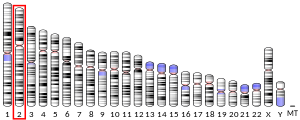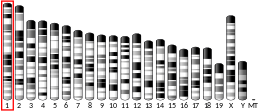Glypican 1
Glypican-1 (GPC1) is a protein that in humans is encoded by the GPC1 gene.[5][6] GPC1 is encoded by human GPC1 gene located at 2q37.3.[7] GPC1 contains 558 amino acids with three predicted heparan sulfate chains.[7]
Function
[edit]Cell surface heparan sulfate proteoglycans are composed of a membrane-associated protein core substituted with three heparan sulfate chains.[7] Members of the glypican-related integral membrane proteoglycan family (GRIPS) contain a core protein anchored to the cytoplasmic membrane via a glycosyl phosphatidylinositol linkage. These proteins may play a role in the control of cell division and growth regulation.[6]
Interactions
[edit]Glypican 1 has been shown to interact with SLIT2.[8]
Clinical significance
[edit]This protein is involved in the misfolding of normal prion proteins in the cell membrane to the infectious prion form.[9]
In 2015 it was reported that the presence of this protein in exosomes in patients' blood is able to detect early pancreatic cancer with absolute specificity and sensitivity.[10] However this conclusion is disputed.[11] and in more recent overviews of potential markers for pancreatic cancer, Glypican 1 is not mentioned.[12][13]
Therapeutic antibodies against GPC1 have been developed.[14][15][16][17] GPC1 has been evaluated as a potential target for cancer therapy,[7] including antibody-drug conjugates,[18] CAR-T cell therapy,[16][15][17] radiotherapy,[19] bispecific T cell engager[20] and immunotoxins[14] in preclinical studies. HM2 is a mouse monoclonal antibody targeting the C-terminal end of GPC1 developed by the laboratory of Mitchell Ho at the NCI, NIH (Bethesda, US).[17] The Ho lab also produced a dromedary camel VHH nanobody called D4 specific for GPC1.[17]The D4 VHH nanobody-based CAR-T cells[17] and immunotoxins[14] were active against pancreatic cancer in mice. Miltuximab, a chimeric antibody against GPC1, was tested in radioimmunotherapy models of prostate cancer.[21]
See also
[edit]References
[edit]- ^ a b c GRCh38: Ensembl release 89: ENSG00000063660 – Ensembl, May 2017
- ^ a b c GRCm38: Ensembl release 89: ENSMUSG00000034220 – Ensembl, May 2017
- ^ "Human PubMed Reference:". National Center for Biotechnology Information, U.S. National Library of Medicine.
- ^ "Mouse PubMed Reference:". National Center for Biotechnology Information, U.S. National Library of Medicine.
- ^ Vermeesch JR, Mertens G, David G, Marynen P (January 1995). "Assignment of the human glypican gene (GPC1) to 2q35-q37 by fluorescence in situ hybridization". Genomics. 25 (1): 327–329. doi:10.1016/0888-7543(95)80152-C. PMID 7774946.
- ^ a b "Entrez Gene: GPC1 glypican 1".
- ^ a b c d Pan J, Ho M (November 2021). "Role of glypican-1 in regulating multiple cellular signaling pathways". American Journal of Physiology. Cell Physiology. 321 (5): C846 – C858. doi:10.1152/ajpcell.00290.2021. PMC 8616591. PMID 34550795.
- ^ Ronca F, Andersen JS, Paech V, Margolis RU (August 2001). "Characterization of Slit protein interactions with glypican-1". The Journal of Biological Chemistry. 276 (31): 29141–29147. doi:10.1074/jbc.M100240200. PMID 11375980.
- ^ Taylor DR, Whitehouse IJ, Hooper NM (November 2009). "Glypican-1 mediates both prion protein lipid raft association and disease isoform formation". PLOS Pathogens. 5 (11): e1000666. doi:10.1371/journal.ppat.1000666. PMC 2773931. PMID 19936054.
- ^ Melo SA, Luecke LB, Kahlert C, Fernandez AF, Gammon ST, Kaye J, et al. (July 2015). "Glypican-1 identifies cancer exosomes and detects early pancreatic cancer". Nature. 523 (7559): 177–182. Bibcode:2015Natur.523..177M. doi:10.1038/nature14581. PMC 4825698. PMID 26106858.
- ^ Discussions at www.pubpeer.com; https://pubpeer.com/publications/70714D8ACB8F13164A2752B4335F38#fb119888
- ^ Balasenthil S, Huang Y, Liu S, Marsh T, Chen J, Stass SA, et al. (August 2017). "A Plasma Biomarker Panel to Identify Surgically Resectable Early-Stage Pancreatic Cancer". Journal of the National Cancer Institute. 109 (8). doi:10.1093/jnci/djw341. PMC 6059209. PMID 28376184.
- ^ Chang JC, Kundranda M (March 2017). "Novel Diagnostic and Predictive Biomarkers in Pancreatic Adenocarcinoma". International Journal of Molecular Sciences. 18 (3): 667. doi:10.3390/ijms18030667. PMC 5372679. PMID 28335509.
- ^ a b c Pan J, Li N, Renn A, Zhu H, Chen L, Shen M, et al. (June 2022). "GPC1-Targeted Immunotoxins Inhibit Pancreatic Tumor Growth in Mice via Depletion of Short-lived GPC1 and Downregulation of Wnt Signaling". Molecular Cancer Therapeutics. 21 (6): 960–973. doi:10.1158/1535-7163.MCT-21-0778. PMC 9167738. PMID 35312769.
- ^ a b Kato D, Yaguchi T, Iwata T, Katoh Y, Morii K, Tsubota K, et al. (March 2020). "GPC1 specific CAR-T cells eradicate established solid tumor without adverse effects and synergize with anti-PD-1 Ab". eLife. 9. doi:10.7554/eLife.49392. PMC 7108862. PMID 32228854.
- ^ a b Li N, Li D, Ren H, Torres M, Ho M (2019-07-01). "Abstract 2309: Chimeric antigen receptor T-cell therapy targeting glypican-1 in pancreatic cancer". Immunology. 79 (13_Supplement). American Association for Cancer Research: 2309. doi:10.1158/1538-7445.am2019-2309. S2CID 216597566.
- ^ a b c d e Li N, Quan A, Li D, Pan J, Ren H, Hoeltzel G, et al. (April 2023). "The IgG4 hinge with CD28 transmembrane domain improves VHH-based CAR T cells targeting a membrane-distal epitope of GPC1 in pancreatic cancer". Nature Communications. 14 (1): 1986. Bibcode:2023NatCo..14.1986L. doi:10.1038/s41467-023-37616-4. PMC 10082787. PMID 37031249.
- ^ Matsuzaki S, Serada S, Hiramatsu K, Nojima S, Matsuzaki S, Ueda Y, et al. (March 2018). "Anti-glypican-1 antibody-drug conjugate exhibits potent preclinical antitumor activity against glypican-1 positive uterine cervical cancer". International Journal of Cancer. 142 (5): 1056–1066. doi:10.1002/ijc.31124. PMID 29055044.
- ^ Yeh MC, Tse BW, Fletcher NL, Houston ZH, Lund M, Volpert M, et al. (May 2020). "Targeted beta therapy of prostate cancer with 177Lu-labelled Miltuximab® antibody against glypican-1 (GPC-1)". EJNMMI Research. 10 (1): 46. doi:10.1186/s13550-020-00637-x. PMC 7206480. PMID 32382920.
- ^ Lund ME, Howard CB, Thurecht KJ, Campbell DH, Mahler SM, Walsh BJ (December 2020). "A bispecific T cell engager targeting Glypican-1 redirects T cell cytolytic activity to kill prostate cancer cells". BMC Cancer. 20 (1): 1214. doi:10.1186/s12885-020-07562-1. PMC 7727117. PMID 33302918.
- ^ Sabanathan, Dhanusha; Campbell, Douglas; Velonas, Vicki; Wissmueller, Sandra; Mazure, Hubert; Trifunovic, Marko; Poursoltan, Pirooz; Ho-Shon, Kevin; Mackay, Tiffany; Lund, Maria; Lu, Yanling; Roach, Paul; Bailey, Dale; Walsh, Bradley; Gillatt, David (May 2021). "Safety and tolerability of Miltuximab® - a first in human study in patients with advanced solid cancers". Asia Oceania Journal of Nuclear Medicine and Biology. 9 (2): 86–100. doi:10.22038/aojnmb.2021.55600.1386. PMC 8255523. PMID 34250138.
Further reading
[edit]- Karthikeyan L, Maurel P, Rauch U, Margolis RK, Margolis RU (October 1992). "Cloning of a major heparan sulfate proteoglycan from brain and identification as the rat form of glypican". Biochemical and Biophysical Research Communications. 188 (1): 395–401. doi:10.1016/0006-291X(92)92398-H. PMID 1417860.
- David G, Lories V, Decock B, Marynen P, Cassiman JJ, Van den Berghe H (December 1990). "Molecular cloning of a phosphatidylinositol-anchored membrane heparan sulfate proteoglycan from human lung fibroblasts". The Journal of Cell Biology. 111 (6 Pt 2): 3165–3176. doi:10.1083/jcb.111.6.3165. PMC 2116352. PMID 2148568.
- Maruyama K, Sugano S (January 1994). "Oligo-capping: a simple method to replace the cap structure of eukaryotic mRNAs with oligoribonucleotides". Gene. 138 (1–2): 171–174. doi:10.1016/0378-1119(94)90802-8. PMID 8125298.
- Suzuki Y, Yoshitomo-Nakagawa K, Maruyama K, Suyama A, Sugano S (October 1997). "Construction and characterization of a full length-enriched and a 5'-end-enriched cDNA library". Gene. 200 (1–2): 149–156. doi:10.1016/S0378-1119(97)00411-3. PMID 9373149.
- Kleeff J, Ishiwata T, Kumbasar A, Friess H, Büchler MW, Lander AD, Korc M (November 1998). "The cell-surface heparan sulfate proteoglycan glypican-1 regulates growth factor action in pancreatic carcinoma cells and is overexpressed in human pancreatic cancer". The Journal of Clinical Investigation. 102 (9): 1662–1673. doi:10.1172/JCI4105. PMC 509114. PMID 9802880.
- Gengrinovitch S, Berman B, David G, Witte L, Neufeld G, Ron D (April 1999). "Glypican-1 is a VEGF165 binding proteoglycan that acts as an extracellular chaperone for VEGF165". The Journal of Biological Chemistry. 274 (16): 10816–10822. doi:10.1074/jbc.274.16.10816. PMID 10196157.
- Liang Y, Annan RS, Carr SA, Popp S, Mevissen M, Margolis RK, Margolis RU (June 1999). "Mammalian homologues of the Drosophila slit protein are ligands of the heparan sulfate proteoglycan glypican-1 in brain". The Journal of Biological Chemistry. 274 (25): 17885–17892. doi:10.1074/jbc.274.25.17885. PMID 10364234.
- Schofield KP, Gallagher JT, David G (November 1999). "Expression of proteoglycan core proteins in human bone marrow stroma". The Biochemical Journal. 343 Pt 3 (Pt 3): 663–668. doi:10.1042/0264-6021:3430663. PMC 1220599. PMID 10527946.
- Karumanchi SA, Jha V, Ramchandran R, Karihaloo A, Tsiokas L, Chan B, et al. (April 2001). "Cell surface glypicans are low-affinity endostatin receptors". Molecular Cell. 7 (4): 811–822. doi:10.1016/S1097-2765(01)00225-8. PMID 11336704. S2CID 43358048.
- Matsuda K, Maruyama H, Guo F, Kleeff J, Itakura J, Matsumoto Y, et al. (July 2001). "Glypican-1 is overexpressed in human breast cancer and modulates the mitogenic effects of multiple heparin-binding growth factors in breast cancer cells". Cancer Research. 61 (14): 5562–5569. PMID 11454708.
- Alvarez K, Fadic R, Brandan E (2002). "Augmented synthesis and differential localization of heparan sulfate proteoglycans in Duchenne muscular dystrophy". Journal of Cellular Biochemistry. 85 (4): 703–713. doi:10.1002/jcb.10184. hdl:10533/173369. PMID 11968010. S2CID 20243469.
- Ding K, Mani K, Cheng F, Belting M, Fransson LA (September 2002). "Copper-dependent autocleavage of glypican-1 heparan sulfate by nitric oxide derived from intrinsic nitrosothiols". The Journal of Biological Chemistry. 277 (36): 33353–33360. doi:10.1074/jbc.M203383200. PMID 12084716.
- Belting M, Mani K, Jönsson M, Cheng F, Sandgren S, Jonsson S, et al. (November 2003). "Glypican-1 is a vehicle for polyamine uptake in mammalian cells: a pivital role for nitrosothiol-derived nitric oxide". The Journal of Biological Chemistry. 278 (47): 47181–47189. doi:10.1074/jbc.M308325200. PMID 12972423.
- Watanabe N, Araki W, Chui DH, Makifuchi T, Ihara Y, Tabira T (June 2004). "Glypican-1 as an Abeta binding HSPG in the human brain: its localization in DIG domains and possible roles in the pathogenesis of Alzheimer's disease". FASEB Journal. 18 (9): 1013–1015. doi:10.1096/fj.03-1040fje. PMID 15084524. S2CID 83560098.
- Li J, Kleeff J, Kayed H, Felix K, Penzel R, Büchler MW, et al. (August 2004). "Glypican-1 antisense transfection modulates TGF-beta-dependent signaling in Colo-357 pancreatic cancer cells". Biochemical and Biophysical Research Communications. 320 (4): 1148–1155. doi:10.1016/j.bbrc.2004.06.063. PMID 15249209.
- Davies EJ, Blackhall FH, Shanks JH, David G, McGown AT, Swindell R, et al. (August 2004). "Distribution and clinical significance of heparan sulfate proteoglycans in ovarian cancer". Clinical Cancer Research. 10 (15): 5178–5186. doi:10.1158/1078-0432.CCR-03-0103. PMID 15297422. S2CID 396257.





